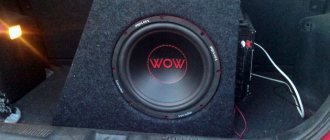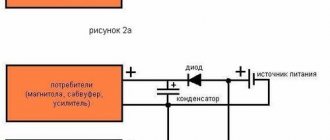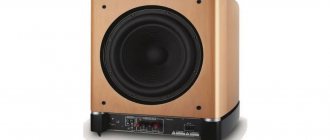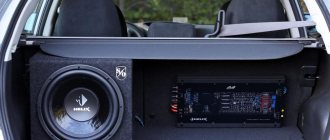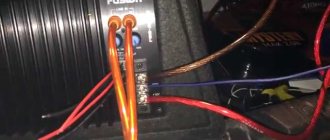A very common question in the car audio industry is “Which should I choose—two 12-inch subwoofers or one 15-inch subwoofer?”
But for the sake of correctness, let’s rephrase this question a little and it will sound like this – “One large subwoofer or two smaller ones?” Since two 12" subwoofers are not equivalent to one 15" subwoofer, in this case you are choosing two different layouts. But we will return to this later.
Before you start, you need to immediately talk about some points. And let's immediately define the concept. We will consider subwoofers in a vacuum, that is, without taking into account the other components of the system, and we will not take into account the need to coordinate the low-frequency section with the rest of the speaker system. Also, we will not waste time on component levels and will mean subs from the same manufacturer line.
One of the main factors affecting the sound will be the effective area of the diffuser. So the equivalent of one 15th subwoofer would be not two 12ths, but two 10ths. This is an approximate equation and the table below shows the closest ratios.
This is why when choosing between two 12-inch subwoofers and one 15-inch, in essence, you are choosing two different layouts. And if the question is: “What to choose for the same amplifier?”, then this is a topic for the next article.
But let's return to a competent comparison.
So, we have found out the approximate ratio of areas.
Occupied volume
One of the most important factors is the volume occupied. For solutions of equivalent area, the volume for one large subwoofer will be 2-3 times larger. So when choosing, you should start by assessing the available space . For example, for the average 12th speaker, the total volume will be about 120-150 liters, which is sometimes difficult to fit in a sedan, while for the 18th speaker you will need 220-280 liters, and with such a volume problems can even arise at the hatchback. So be sure to keep this in mind when making your choice.
Music
The next point when choosing is the nature of the music for which you are choosing a subwoofer. It must be said right away that the opinion that a large sub will be slower or the bass will be fatter is a common misconception. This will be influenced more by the design and connection to the amplifier than by the size of the sub.
But the general rule is that the lower the setting, the more the speaker works here. Buy one large subwoofer if you listen to low tracks and opt for a smaller pair if you want versatility or higher tuning. This is related to the resonant frequency (Fs), since for larger ones it is usually lower.
There is also one nuance related to the size of the diffuser. At higher settings, due to the fast movement and large diameter, the edge of the diffuser will lag slightly behind due to natural deformation. And the faster its movement, the more distortion will occur, and accordingly, not the entire area will work. Of course, this is a rather microscopic nuance in these modes and it very much depends on the materials. Here's a little bit, but let's repeat - this is not about group delays and bass depth.
HONEY & TAR
Today Polk turned out to be the winner confidently, even with style. This is the only head in the group of “two-pieces” that: a) does not make excessive demands on the bass of the fronts, b) is capable of playing the “zero” frequency response in a completely sane size and c) does this without large nonlinear distortions. Or rather, doing this with little ones. DLS and Challenger scored a point less, so both become “Favourites”. DLS stands out from the general background with a fairly high return, Challenger with a low level of nonlinearity. We would like to recommend the Hyundai subwoofer as the only inexpensive speaker of this caliber that can operate in an acoustic screen without compromising performance in the housing.
The era of cassette car radios and the “tinny” sound pouring into the ears of passengers and car drivers from homemade sound systems or speakers is becoming a thing of history. Very quickly, car enthusiasts appreciated the benefits of digital sound and the advantages of high-quality audio equipment, in particular subwoofers. These devices complemented the standard acoustics with powerful bass, which made it possible to enjoy rich sound that caused a friendly run of “goosebumps” on the skin. In our rating of the best active and passive subwoofers for cars, we tried to cover the most interesting (according to reviews from car enthusiasts and experts) models in different price categories.
Sound
Well, the third point, the most interesting, is of course the sound. But it's not that simple. No matter how we neglect the conditions and try to equalize positions, speakers even in the same manufacturer’s line will have different characteristics, different Thiel-Small parameters, which determine the sound of the speaker.
So, speakers of different sizes will always differ in sound, since their physical properties will be different, such as the size of the coil, its weight, the diameter of the washer, etc.
So let's take a look at the general trends. What can be noticed with the naked eye is that the larger the subwoofer, the lower its resonant frequency, and in general the ratio of resonant frequency to quality factor decreases, which is good for a closed box.
But who takes large subwoofers for closed boxes! And this, by the way, is another omission and misconception; large subwoofers work great in ZY, if we are talking about a good and balanced sound of the system.
So let's take a couple of examples from the same line and apply the recommended volumes to them, choosing the same setting of 35 Hz.
As you can see, a large subwoofer reaches low frequencies more smoothly and has better output there, while a pair of speakers has higher efficiency in the tuning area . Another interesting point, look, a couple of subs will have longer time delays, while a large one will have better accuracy.
Of course, by selecting the characteristics of the housing, you can practically equalize the presented frequency responses, but we are talking about volumes that are recommended as optimal in order to obtain a clear difference in sound characteristics.
So, when choosing between a pair of smaller speakers and one larger one, consider how much volume you have, the setup of your future enclosure, your financial costs and the nature of the sound due to the specific parameters.
How to choose a subwoofer for a car
A subwoofer is a special loudspeaker designed to reproduce low-frequency sounds. It has a large diffuser diameter and is designed in most cases to produce sound waves in the range of 10-150 Hz. Keep in mind that the sub is intended to complement the already installed car speakers, and not to completely replace the bass. This means that even without it, the “upper bass” (about 80-200 Hz) should play normally. The optimal option for standard acoustics is 5 speakers - 2 in front, 2 in rear, and 1 subwoofer. One subwoofer in a car is quite enough, since the human ear does not perceive the direction of low-frequency sound. It is very desirable if there are “tweeters” in front - special high-frequency speakers with a relatively small diffuser diameter.
Subwoofers for cars are divided into cabinet and open types. As the name suggests, the former are supplied in a case, the volume of which is usually measured in liters, while the latter are supplied without a case. They crash into the rear parcel shelf or the back seat of the car. Cabinet subs are divided into active and passive. The active ones have a built-in power amplifier coupled with a frequency divider (crossover). And the passive sub is deprived of them. Therefore, their prices differ by 2-3 times. The sad fact is that in order to reduce the cost, lower-quality speakers are installed in active subwoofers. If you have not very expensive acoustics without a separate amplifier and a car with a hatchback or station wagon, then it is better to choose an active subwoofer. The shelf above the trunk will not prevent bass from penetrating into the body. And in sedans, the right decision would be to embed an open air speaker into the rear seat. The power will come from a separate amplifier, and the trunk will act as an excellent case.
Boxed subwoofers come in three types: 1. Closed box with speaker. There are no holes for air to pass through. This type is distinguished by its relatively small size, clear bass, but its sound is weaker.
2. Box with bass reflex. A bass reflex is a hole in the housing with a port for air to pass through. Its size, shape and location must be carefully calculated when designing a subwoofer. An incorrectly assembled device will wheeze and “fart.” Therefore, when purchasing, give preference to famous and well-established companies. The bass reflex significantly increases the depth and pressure of sound. Is the most common type.
3. Band pass box. Here the speaker is inside the box, and the sound comes from the bass reflex. The bass is deep, but quiet and tends to buzz. They are more designed for beauty, so the body is often made transparent and provided with spectacular lighting.
The main speaker diameters are 8, 10, 12, 15 inches. Naturally, the larger the size, the greater the power and dimensions. The optimal solution for most motorists is 10-12 inches.
Grisha 05/28/2009 15:14 I really like Pioneer. The bass hits you to the core! :like:
Renat 12/06/2011 08:56 can you tell me which pioneer? what is the rated power? Because I want to install a pioneer, but I don’t know which one.
Dima 09/04/2012 04:00 Better take Sound Down if you want a good sub!!
Dmitry 123 10/11/2012 23:08 This is hardly a good sub, but SunDown...


